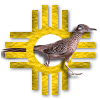Page B. Otero Santa Fé County, New Mexico
Page B. Otero, of Santa Fé has been identified with public affairs for several years. A son of Miguel A. Otero, deceased, he was born in Washington, D. C, January 14, 1858, and concluded his classical studies in the University of St. Louis and Notre Dame (Indiana) College. He studied medicine for three years in Chicago, but did not work up to a degree, abandoning his studies to assist his father in his mercantile undertakings in Kansas, Colorado and New Mexico. In 1880 he helped to organize the New Mexico Telephone Company, with headquarters in Las Vegas, became superintendent of line construction, and established exchanges at Las Vegas, Santa Fé, Albuquerque and Socorro. He was afterward engaged in mining in New Mexico and Arizona. After serving for a while as deputy United States marshal he went to Roswell in 1890 and engaged in the sheep business with Pat F. Garrett for a year, while "later he superintended the construction of the Mining Exchange building in Denver. He then became chief deputy United States marshal under Romulo Martinez, serving from 1885 to 1889. From 1891 to 1892 he was deputy sheriff and tax collector of Bernalillo County. During most of the life of the United States court of private land claims he acted as special agent for the government and arrested James Addison Reavis, the notorious swindler. Upon the outbreak of the Spanish-American war he entered the First New Mexico Volunteer Cavalry as first lieutenant, was promoted to major, and remained with that command until it was mustered out. Upon his return he was again identified with the land court. He framed and caused to be introduced the bill creating the office of game warden for New Mexico, was appointed to that office by his brother, Governor Otero, and occupied it until the appointment of his successor April 27, 1906.
Back | Santa Fe County Biographies
Source: History of New Mexico, Its Resources and People, Volume II, Pacific States Publishing Co., 1907.
©New Mexico American History and Genealogy Project
2011 - 2024
Created 1996 by Charles Barnum & 2016 by Judy White
